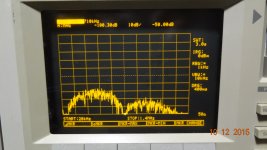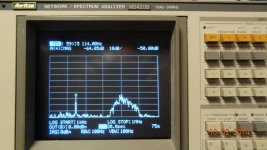I am still never sure why, in 2019 we still have a view from some that subjectivist and objectivist are opposite camps in their entirety, hiding behind their cardboard box forts and hurling insults at each other. Surely we have come further than that in the last 30 years?
And for light relief Superb Sound at Definitive's Music Matters 14 | Stereophile.com . unsuprisingly the reviewer likes the sound of a million dollar system. Not a bybee in sight, but a $60,000 equipment rack. Boggle. Had to check the manufacturer out. Sure enough they state a military/space background! For that money you could put a minus-k under everything.
And for light relief Superb Sound at Definitive's Music Matters 14 | Stereophile.com . unsuprisingly the reviewer likes the sound of a million dollar system. Not a bybee in sight, but a $60,000 equipment rack. Boggle. Had to check the manufacturer out. Sure enough they state a military/space background! For that money you could put a minus-k under everything.
No, but I hope to be at least be able to get a better meausure of how bad it isIf you would make a claim for accuracy for a combo at any price, you think that you would be able to provide any proof when asked for?
I had to count...All right but still no answer to the question
George
Including duplicates and freebies I might never use I have 7 MC and 14 MM. I have been fair and included ortofon OM, superOM, LM, concorde and S120 in that. I need to thin the herd a bit more...
+1... hurling insults at each other. Surely we have come further than that in the last 30 years?...
Many of the insults really obscure what is being said while adding more confusion to many. What is it that makes it difficult to be civil?
No, but I hope to be at least be able to get a better meausure of how bad it is
I had to count...
Including duplicates and freebies I might never use I have 7 MC and 14 MM. I have been fair and included ortofon OM, superOM, LM, concorde and S120 in that. I need to thin the herd a bit more...
I'll take them all off your hands and offer $25.00 to help cover the shipping. But a clever guy might just trade them for a couple of new releases they were mentioning a bit ago.
When it comes to the sound and measurements of speakers different rules seem to apply. Speakers can sound vastly different and yet it's said that their distortions can be much larger than those in the electrical chain without the same detriment to quality, where does this idea come from?This is great contrast to all the zealot jerks on AVS forum that will go all out pitch-fork hunt on you for telling them DACs sound different. They claim the measurements mean they sound the same. Hmm do I trust a bunch of biased people or the manufacturers offering solutions on different filter tastes... hmm
As stated before, while that is true, nobody ensures that something of this kind is available even on a audio CD, for the same reason as nobody prevents us from using a one sample impuls on a CD for measuring purposes.
Inter-sample overs are not a Nyquist violation. You are welcome to provide examples of full scale transitions in one sample period on CD's of music or provide a link to a study of the matter. Articles that talk about musical "transients" and show Gibb's effect on impulses are intellectually dishonest IMO. A spark discharge recorded at 96kHz with a wideband 1/4" mic shows no Gibbs ringing.
Inter-sample overs are not a Nyquist violation.
I know, but i think it is a good example of an effect that should not have happen but did nevertheless because nobody checked the output for something like that.
Working with numbers and calculations allows for waveforms that aren´t possible if recorded in a traditional way.
You are welcome to provide examples of full scale transitions in one sample period on CD's of music or provide a link to a study of the matter. Articles that talk about musical "transients" and show Gibb's effect on impulses are intellectually dishonest IMO. A spark discharge recorded at 96kHz with a wideband 1/4" mic shows no Gibbs ringing.
Mhm, i think that misses the point.
Therefore i provided the measurement example; nobody prevents us to use a one-sample impulse on a audio cd for measurement purposes and it is not even a Red Book violation. Although it is done intentionally would you really bet that it does not happen unintentionally?
Last edited:
I'll take them all off your hands and offer $25.00 to help cover the shipping. But a clever guy might just trade them for a couple of new releases they were mentioning a bit ago.
I cannot replace the pleasure of retiring to the sofa and listening to vinyl with the wife of an evening. No logical reason for it but as a shared experience it ends the day nicely.
The other 19 are for experimentation and fun. Just cos a technology was obsolete 35 years ago doesn't mean one can't still mess with optimisation of it as a hobby after all.
I know, but i think it is a good example of an effect that should not have happen but did nevertheless because nobody checked the output for something like that.
Sorry again well known outside of audio and like dither common engineering knowledge was ignored again. If you read the analog filter section of my AD713 datasheet (c. 1986) you will notice that I mention overload on internal stages of analog "brickwall" filters for anti-aliasing, this phenomena was well known.
would you really bet that it does not happen unintentionally?
Certainly with insignificant frequency, yes. Like a tape splice we are left arguing if 2 or 3 instances of something in 30min of music is a "sound".
Last edited:
Sorry again well known outside of audio and like dither common engineering knowledge was ignored again. If you read the analog filter section of my AD713 datasheet (c. 1986) you will notice that I mention overload on internal stages of analog "brickwall" filters for anti-aliasing, this phenomena was well known.
Absolutely, but i fail to see the argument ?!
with insignificant frequency, yes. Like a tape splice we are left arguing if 2 or 3 instances of something in 30min of music is a "sound".
The numbers are just speculative too, aren´t they?
I cannot replace the pleasure of retiring to the sofa and listening to vinyl with the wife of an evening. No logical reason for it but as a shared experience it ends the day nicely.
The other 19 are for experimentation and fun. Just cos a technology was obsolete 35 years ago doesn't mean one can't still mess with optimisation of it as a hobby after all.
Lack of clarity, I just meant the extras!
But, would designing based on the actual pre-A/D (anti-aliasing) filters give a better reproduction? IOW, could a playback (D/A) benefit from detailed knowledge of the pre-A/D filter's characteristics (given whatever computing juice needed etc.) ?
Chris
That is the exact same question I stated. Seems you need to in order to have accuracy to the original source.
THx-RNMarsh
What if a lot of the dac sound is because of insufficient attenuation of aliasing in its filter? Improving the anti-aliasing filter in the ADC is unlikely to cancel that filter problem.
Look at the (audible?) GDelay approaching the cut-off freq.
However, their IS insufficient atten of the filter output. Significant HF energy level is being sent to the amp/speaker. NOT a good idea. It is only -70dBv down and if sent to a preamp/PA with some total gain X ... a lot of HF PA energy is going thru amp and tweeter.


Conjecture --> It may be one reason a faster SR and lower distortion at HF of CFA or current-mode amp reduces some of the IM generated from the high levels of HF present.
Thx-RNMarsh
Last edited:
The numbers are just speculative too, aren´t they?
Classic impasse, who is going to waste their time scanning several 100 commercial CD's to prove a point?
Lack of clarity, I just meant the extras!
I should note that most of the extras are currently not entirely functional at the moment. Retips required on most of them. They were very cheap...
Rather than complaining about the actions of what you call "objectivists", all you have to do is show a proof of what they did ("when people have made claims to that effect in forums such as this, sometimes the claim was dismissed as imaginary because nobody offered a convincing theoretical explanation consistent with prior auditory research, or new measurements and new research proving audibility.") turned out to be incorrect. Can you cite an example or two of such event?
Re-read yourself, Destroyer OS!
You use the same terms and methodology as those you criticize. That surprises me from you. ;-)
An attitude, usual in our forum from those that I call "objectivists", that consists of not checking the subjective observations that are reported by others with a clear bias against them and a final value judgment on their honesty (voluntary or not) or their ability to listen.
To "believe" that our scientific knowledge is such that it covers the whole field of pshycho-acoustics? (Anti-scientific attitude of believers of a new religion they call "science".)
The first thing to do is to observe by ourself to check the observation that is reported.
If we can not reproduce it, we can then question first our own listening ability or the performance of our system. And report the negative result of our own observation by modestly specifying that it is only valid for ourself in the conditions in which they were made.
The second thing to do is to check whether the explanation given by others to the phenomenon or to the solutions they bring does not contradict scientific knowledge that has been verified a thousand times. If so, we can talk about snake oil. Otherwise the subject remains open and our own opinion is not worth more than that of those who are criticized.
Do not make me say what I do not say, I have no conclusions on this subject of the "SOUND of the DAC", that personally, I consider as open. Especially since the few measures that I have been able to do clearly show differences in the measurements of square waves between different performance DACs close to the paper, and that, by myself, I noticed very slight differences in the way they reproduce music. Slight enough to not to put this problem in head of the things to improve on * my personal system *.
Money. Don't forget that there are those who post in the interest of business.+1
Many of the insults really obscure what is being said while adding more confusion to many. What is it that makes it difficult to be civil?
- Status
- Not open for further replies.
- Home
- Member Areas
- The Lounge
- John Curl's Blowtorch preamplifier part III
